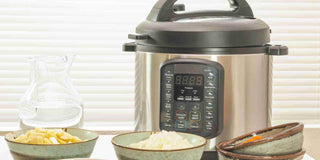“Energy efficiency is the art of getting more by using less.”
This perfectly encapsulates our electric slow cooker.
Every kitchen, from the heart of bustling cities to cosy countryside homes, has embraced this culinary marvel. But amidst all the chatter about tender meats and flavorful stews, there's a burning question on many minds: How energy efficient are these electric slow cookers?
Let's uncover the facts behind this modern kitchen sensation. Does it use a lot of energy? Or is it our go-to kitchen gadget when we talk about sustainability?
Understanding The Electric Slow Cooker
Diving into the Electric Slow Cooker
An electric slow cooker is a kitchen gadget designed to cook dishes over prolonged periods using gentle heat. Instead of the quick sizzle of a stovetop or the blazing heat of an oven, this device embraces patience, ensuring flavours meld harmoniously.
Basics and How It Works
Central to the electric slow cooker is the electric slow cooker base, the heart that powers the device. This base warms up, ensuring the pot's contents are cooked uniformly and gently. Modern iterations of this device often come with diverse settings, letting you tailor the cooking time and heat level.
Modern Cooking's Best Friend
A standout trait in many of today's models is the electric slow cooker with a timer. This nifty feature lets you dictate your cooking duration, and once that's up, the device usually shifts to a 'warm' mode. This ensures your culinary creations stay hot without getting overdone, a boon for those always on the move. Prep your ingredients, dial in the timer, and let the day roll. When you return, a warm, aromatic dish awaits.
Important note:
While "slow cook" and "cooker" might seem synonymous, there's a subtle difference. "Slow cook" denotes the gradual cooking technique, while "cooker" refers to the tool itself. The electric slow cooker marries these concepts, offering both the method (slow cook) and the mechanism (cooker) for mouthwatering outcomes.
Key Components of an Electric Slow Cooker
Electric Slow Cooker Base
The base is the foundation and powerhouse of the electric slow cooker. It's where the magic begins. Here's a breakdown:
Heating Element: Nestled within the base is the heating element responsible for generating the consistent and controlled heat required for slow cooking. Unlike traditional stovetops that apply direct heat from below, the base of a slow cooker ensures even heat distribution, wrapping your food in a gentle, warm embrace.
Temperature Controls: Located on the base, these controls allow you to set the desired cooking temperature. Whether you want a simmering low, a medium boil, or a high sear, the base's controls let you dictate the pace.
Timer and Settings: Modern electric slow cookers often have timers and programmable settings. These are integrated into the base, allowing you to customise your cooking duration. Once the set time is up, many cookers automatically switch to a 'keep warm' mode, ensuring your food remains at the perfect temperature without overcooking.
Stability and Support: The base isn't just about heat and controls. It's also designed to offer stability, ensuring the cooker sits firmly on your countertop. Additionally, it supports the pot or inserts, providing optimal contact for even heat distribution.
Electric Slow Cooker with Timer
At first glance, a timer is another digital addition. But in the world of slow cooking, it's a revolution. Here's why:
Set and Forget: One of the most significant advantages of having a timer is its "set and forget" convenience. Instead of periodically checking on your dish or worrying about overcooking, you can simply set the desired cooking duration and go about your day. The cooker will do its job, and once the time is up, it'll either switch off or move to a 'keep warm' mode.
Energy Efficiency: Timers contribute significantly to energy conservation. By ensuring the cooker operates only for the required duration, there's no unnecessary energy consumption. Once the cooking is done, the device won't continue to draw power for extended periods, making it an eco-friendly choice.
Precision Cooking: Every dish has its own sweet spot for cooking time. A timer allows you to hit that spot consistently. Whether it's a tender pot roast that needs six hours or a vegetable stew that's perfect in four, the timer ensures your dishes are cooked to perfection every single time.
Safety: Leaving any appliance running longer than necessary can pose safety risks. With a timer, once the cooking is complete, the slow cooker will cease its operation or shift to a safer mode, reducing potential hazards.
Energy Consumption: Myths and Facts

Does an Electric Slow Cooker Use a Lot of Energy?
Duration vs. Intensity: One of the common misconceptions is that because a slow cooker runs for several hours, it must be using a lot of energy. However, it's essential to differentiate between duration and intensity. While a slow cooker operates over extended periods, it does so at a low, consistent temperature. This is in stark contrast to an oven that heats up to high temperatures and consumes more energy in a shorter time frame.
Comparative Consumption: When you stack up the energy usage of a slow cooker against other kitchen mainstays, the results might surprise you. For instance, a standard oven can consume around 1000-5000 watts, depending on its size and type. In contrast, a typical slow cooker uses between 70 and 250 watts. Even over several hours, the slow cooker's cumulative energy consumption is often less than that of an oven used for just an hour.
Efficiency in Design: Slow cookers are designed for efficiency. Their enclosed structure ensures minimal heat loss, meaning most energy consumed is used directly for cooking. This contrasts with stovetops, where a significant amount of heat can escape into the surroundings.
Cost Implications: The slow cooker is a friend for those concerned about electricity bills. Given its efficient energy consumption, using a slow cooker regularly won't lead to any shocking spikes in your monthly expenses.
What Drives Energy Use in Slow Cookers?
Volume Matters: Bigger isn't always better. While a large 7-quart slow cooker might be perfect for big gatherings, it's likely to draw more power than a compact 3-quart variant.
Heat Levels: Naturally, cranking up your cooker to 'high' will use more juice than letting it simmer on 'low'.
Time in Play: Slow cookers are marathon runners, not sprinters. But remember, the longer they're on, the more energy they sip.
Build and Design: Some slow cookers are better at holding onto their warmth, thanks to superior insulation. The pot's material, be it ceramic or metal, can influence its heat retention capabilities.
Wear and Tear: Just like us, as slow cookers age, they might not run as efficiently as they once did.
Ambient Temperature: If it's chilly outside, your slow cooker might need to work harder to keep things toasty inside.
Electric Slow Cookers vs. Power Cookers:
- Slow cookers embrace a gentle, prolonged heat approach. In contrast, power cookers are all about high-temp, quick cooking, thanks to the magic of pressure.
- With their quick-fire approach, power cookers are usually on for a shorter span, potentially saving on energy, even if they draw more power in their active phase.
- Modern power cookers often boast multiple modes, including a nod to slow cooking. While this adds versatility, it also means varied energy consumption patterns.
- With great power (and pressure) comes great responsibility. Power cookers need robust safety mechanisms. Both devices are safe champs, but power cookers might have a steeper learning curve.
- Slow cookers are your go-to for dishes that love a slow simmer, like a hearty stew. But for meals that can be fast-tracked with pressure, like beans, power cookers shine.
Can a Power Cooker Be Used as a Slow Cooker?

Differences and Similarities
Cooking Mechanism:
Power Cooker: Uses pressure to cook food rapidly at high temperatures.
Slow Cooker: Relies on steady, low heat over extended periods to simmer food.
Functionality:
Power Cooker: Often multi-functional, with settings for pressure cooking, rice cooking, steaming, and, in many modern models, even slow cooking.
Slow Cooker: Primarily designed for prolonged cooking, some models offer high and low-temperature settings.
Duration:
Power Cooker: Cooks dishes in a fraction of the time, thanks to the pressure mechanism.
Slow Cooker: Takes its time, allowing flavours to meld over hours.
Pros and Cons of Using a Power Cooker for Slow Cooking
Pros:
Versatility: Many power cookers have a slow cooking function, making them a two-in-one appliance and saving kitchen space.
Temperature Control: Advanced power cookers often have precise temperature controls, allowing for a more tailored slow-cooking experience.
Safety Features: Modern power cookers come with multiple safety features, ensuring that they remain secure even when used for slow cooking.
Cons:
Learning Curve: Using a power cooker for slow cooking might require familiarising oneself with new settings and controls.
Taste Variation: Some purists believe that traditional slow cookers offer a distinct flavour profile, which might be slightly different when using a power cooker's slow cook function.
Heat Distribution: While slow cookers are designed specifically for even heat distribution over long periods, power cookers, when used for slow cooking, might sometimes offer different uniformity.
Key Takeaway:
As we've journeyed through the world of electric slow cookers, one thing stands clear: these devices are not just about convenience but also about energy efficiency. Operating at low temperatures over extended periods, they offer a unique blend of flavourful cooking without the hefty energy bills often associated with high-powered kitchen appliances.
So, as you ponder your next kitchen purchase or how to whip up your next meal, remember to factor in your culinary desires and energy goals. In a world where every watt counts, making informed decisions can lead to delicious outcomes without compromising efficiency.
Explore more on our platform and level up your culinary experience with Megafurniture. Let's cook smart together.
For Home Upgrade, Opt For These Articles:
Interior Design Singapore: Best Firms for Your Next Home Renovation
Your Ultimate Cheat Sheet to Renovation in Singapore: HDB Guidelines, Procedures & Tips
Bonus Treat: Slow Cooker Energy Conservation Hack You Won’t Want To Miss!
Preheat Efficiently
Just like you'd preheat an oven, give your slow cooker a head start by turning it on while prepping ingredients. This ensures it reaches the desired temperature faster once the food is inside.
Optimal Filling
Ensure your slow cooker is between half to three-quarters full. Overfilling can increase cooking time while underfilling might waste energy.
Limit Lid Lifting
You let out heat every time you lift the lid, extending the cooking time. Resist the temptation to check on your dish too often. If you must, try to do so quickly.
Use the Right Size
If you have multiple slow cookers, use the one that best fits the quantity of food you're preparing. A smaller cooker for smaller meals is more energy-efficient than a larger one.
Thaw First
If you're using frozen ingredients, thaw them first. This reduces the slow cooker's time and energy to bring everything up to temperature.
Retain Heat
Place your slow cooker in a location away from drafts or open windows. This helps maintain a consistent temperature inside the cooker.
Batch Cooking
If you're using the slow cooker, consider making larger batches of food. Not only does this save energy, but you also get the bonus of leftovers for future meals.
Use the 'Warm' Setting
Once your food is cooked, switch to the 'warm' setting instead of continuing to cook on 'low'. This keeps your food at the right temperature without using as much energy.
Regular Maintenance
Ensure your slow cooker is clean and in good condition. Build-ups or malfunctions can affect its efficiency.
Plan Ahead
Slow cookers are all about planning. By setting your ingredients in the morning, you can avoid using other appliances that might consume more energy for last-minute meals.
Insulate
For an added layer of energy conservation, you can place a folded kitchen towel on top of the slow cooker's lid. This simple hack helps trap heat, ensuring even more efficient cooking.



